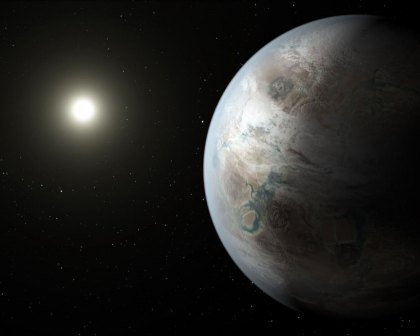NASA:
Planet in habitable zone orbits sunlike star

This distant planet orbits a star similar to our sun. Image: NASA.
Scientists have identified a planet they believe to be more like Earth than any other exoplanet previously discovered -- and it orbits a star similar to our sun. The planet, found through research using the Kepler space observatory, is in the habitable zone -- the right distance from its star to support life, scientists said during a press conference July 23.
Such announcements have been made in the past involving planets that orbited stars different from our own. For example, last year, scientists described a planet that orbited a dwarf star,which researchers say are the smallest and most abundant stars in the galaxy.
While not exactly around the corner (the newly discovered planet is 1,400 light-years away in the constellation Cygnus), this is the first time researchers have found a planet in the habitable zone orbiting a star like our sun. All exoplanets identified until now “orbit stars that are significantly cooler and smaller than the sun,” said Jon Jenkins, Kepler data analysis lead at NASA's Ames Research Center in Moffett Field, California.
Researchers believe there are other parallels between Earth and the planet known as Kepler 452b, named for the Kepler space observatory used to find it.
The planet orbits its star every 385 days, for example. It is just 5 percent farther from its star than Earth is from the sun. Its diameter is 60 percent larger than Earth, and it “has a better than even chance of being rocky,” Jenkins said.
The planet's star is an estimated 6 billion years old, about 1.5 billion years older than our sun. The planet also has been around long enough for life to develop, Jenkins pointed out, "should all the necessary ingredients and conditions for life exist on this planet.”
Researchers consulted with planetary geologists and atmospheric scientists to make suppositions about conditions on the planet. “It would likely have a mass about five times that of Earth,” Jenkins said. “The surface gravity is about twice that of Earth. So you and I would weigh about twice as much as we do now, but only until we walked around for a few weeks and lost some serious pounds.”
The atmosphere would be thicker and have more cloud cover, he said.
Scientists have long sought to answer one big question, said John Grunsfeld, associate administrator for NASA's Science Mission Directorate: Are we alone in the universe?
“We’re going to take one small step in answering that question today,” he said.
With this discovery, the total number of confirmed planetsis 1,030, according to NASA.
Related:
NASA marks verification of 1,000th planet
A primer: Earth's cousin orbits distant star
The 'Interstellar' question: Could we live there?
If you would like to comment, contact StudyHall.Rocks or like us on Facebook and tell us what you think.

